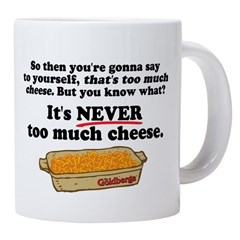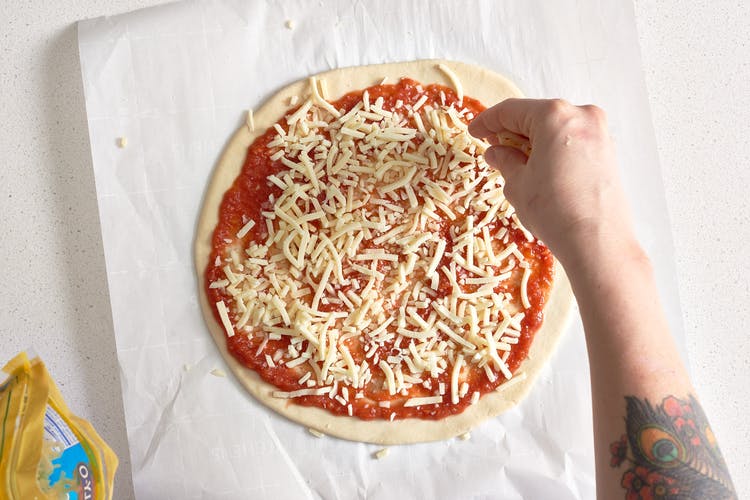6 Things a Savvy Shopper Knows About Buying Mozzarella
To say my family loves cheese is a complete understatement. Take me, for example. I love cheese so much I got this (for myself! ha!) for Christmas this last year.

That is a classic Beverly Goldberg quote. And she couldn’t be more right.
But not all cheeses are created equal. Cheese isn’t the cheapest food money can buy, so in recent years I tried to cut costs and get it the cheapest place I could find it, which for me was Aldi. Yada yada yada...I have since switched to only trusting Tillamook when it comes to my medium cheddar.
For some reason, the ingredients all read the same between the two blocks of cheese but the Aldi one tasted pretty much like Velveeta cheese.
It can be hard to tell which cheeses are what. Specifically, for me, when it comes to the mozzarella variety. There’s shredded cheese. There’s cheese in a block. There’s cheese in a ball….in water :\ (what the heck is that about?!)
Here are some tips from the good folks at thekitchn.com to help us be in the know about when to buy what kinds of mozzarella so you could go head to head in an Italian cook off with Giada De Laurentiis and beat her! ;)
1. Low-moisture mozzarella is the most common mozzarella you'll find in any grocery store.
Stocked in the dairy aisle, near the blocks of cheddar, you're likely to find mozzarella in three forms: blocks, pre-shredded bags, and string cheese. Each one is low-moisture mozzarella, the most widely available form of this cheese in grocery stores.

While it might be labeled as simple "mozzarella," it has a lower water content, denser texture, and a tangier, saltier flavor than mild, milky fresh mozzarella.
2. It's better to buy a block than pre-shredded.
Plastic-wrapped blocks and pre-shredded mozzarella are the most common forms of low-moisture mozzarella for cooking. Given a choice between the two, go with the block and shred it yourself.
There's no denying that those bags of shredded mozzarella are a convenient time-saver. But pre-shredded mozzarella also contains additives that prevent the cheese from clumping together in the bag, which also means it doesn't melt quite the same as freshly grated cheese. Not only does a block of mozzarella skip those additives, but it's also a little bit cheaper.

3. Low-moisture mozzarella is the best choice for an everyday, dependable pizza.
When your goal is a super-classic pizza blanketed with perfectly melted cheese that pulls and stretches after biting into the slice, there's no better cheese to get you there than low-moisture mozzarella. In addition to its A+ meltability, this cheese has a low water content, which means it makes for a pie that's sturdy rather than soggy.
4. The mozzarella that's sold in water is fresh (and comes in many sizes).
Head to the deli section (or perhaps a cheese counter) to find balls of mozzarella submerged in water and packaged in plastic containers. Unlike the mozzarella in the dairy aisle, this is the fresh stuff. It can vary in size from teeny-tiny rounds to the size of a baseball. It has a fresh milky flavor and we love it for margherita pizzas and grain salads.
5. Buy fresh mozzarella when you plan to use it immediately.
Compared to low-moisture mozzarella, which can last for weeks in the fridge, fresh mozzarella has a much shorter shelf life. It's at its best within a couple of days of bringing it home, and starts to spoil shortly after. Plan to buy fresh mozzarella the day of or day before you plan to use it.
6. The way you'll use it is the best indicator of what kind to buy.
With all the mozzarella options, figuring out the best one to buy can feel tricky. To make it easier, think first about how you'll use it. Here are some examples.
Pizza: While you can use a number of different cheeses on pizza, low-moisture mozzarella is our top pick for a classic pie. It comes with the promise wonderfully melted cheese that pulls and stretches, and a pie that's sturdy not soggy.
Baked pasta: Anytime you're making baked pasta, like lasagna or baked ziti, and have the expectation of stringy and gooey melted cheese at the center, opt for low-moisture mozzarella.
Caprese: Fresh mozzarella is a classic choice for caprese, in all its many forms.
Salads: Our top pick for salads is creamy, mild fresh mozzarella. When that's not available, though, pick up a block of low-moisture mozzarella and cut it into chunks.
- www.thekitchn.com
- www.cafepress.com
 Mary Richardson
Mary Richardson
Weekly Newsletter Contributor since 2014
Email the author! mary@dvo.com
